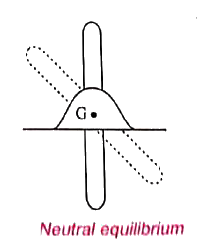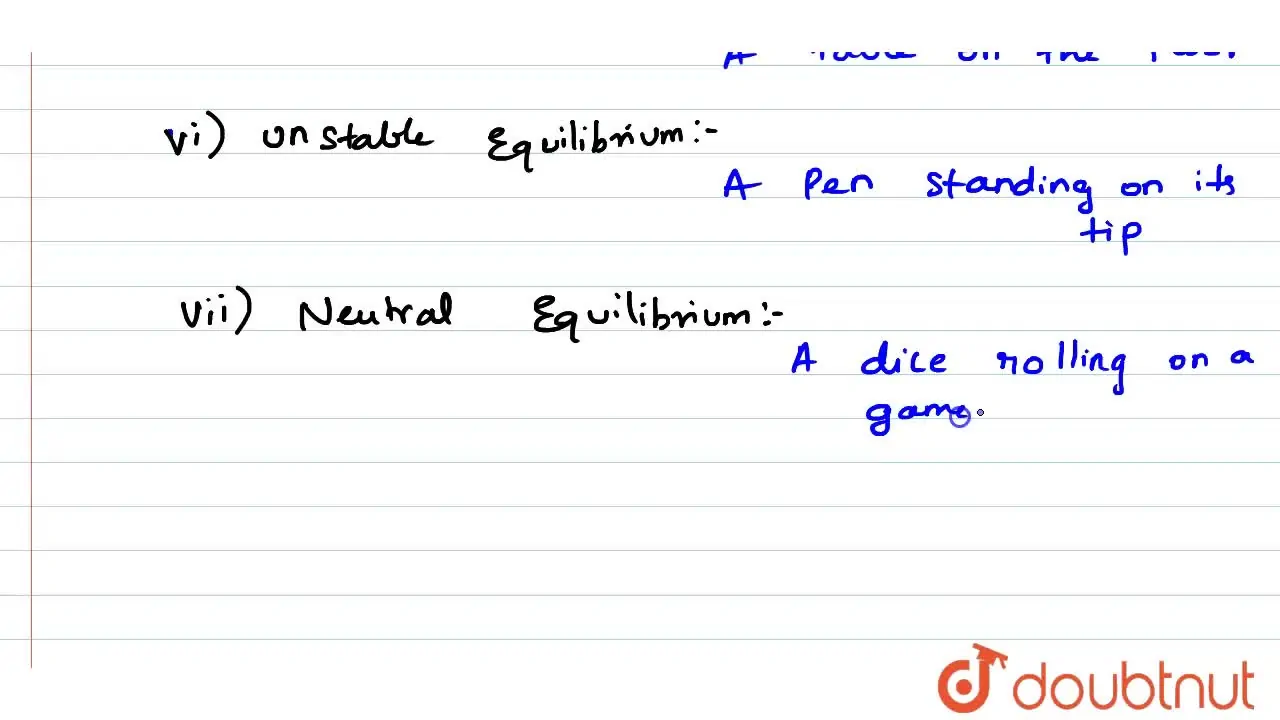Explain the types of equilibrium with suitable examplesSolution in Tamil
(i) Linear momentum and angular momentum are zero.
(ii) The body tries to come back to equilibrium if slightly disturbed and released.
(iii) The centre of amss of the body shifts slightly higher if disturbed from equilibrium.
(iv) Potential energy of the body is minimum and it increases if disturbed.

A bar is fixed at its top end. If its centre of gravity G rises to G1 on being displaced, then the bar returns back to its original positioni on being released. Hence the equilibrium of a bar is stable.
In unstable equilibrium.
(i) Linear moment and angular momentum are zero.
(ii) The body cannot come back to equilibrium. if slilghtly disturbed and released.
(iii) The centre of mass of the body is shifted slightly lower if disturbed from equilibrium.
(iv) Potential energy of the body isnot minimum and it decreases if disturbed.

Consider a bar B, whose fixed end is at its bottom. Its centre of gravity G is lowered to G2 on being displaced, then the bar B will keep moving awya from its original position on being released. Hence the equilibrium is said to be unstable.
In neutral equilibrium :
(i) Linear momentum and angular momenum are zero.
(ii) The body remains at the same equilibrium if slightly disturbed and released.
(iii) The centrre of mass of the body does not shift higher or lower if disturbed from equilibrium.
(iv) Potential energy remains same even if disturbed.

For a bar C, whose fixed point is baout its centre of gravity. If the centre of gravity remainses as the same height on being displaced then the bar will remain in its new position. On being released and the equilibrium is said to be neutral.
Related Playlists
- BOOK - PREMIERS PUBLISHERSCHAPTER - MOTION OF SYSTEM OF PARTICLES AND BODIESEXERCISE - TEXTBOOK QUESTIONS & ANSWERS (CONCEPTUAL QUESTIONS)16videos
MOTION OF SYSTEM OF PARTICLES AND BODIES
- BOOK - PREMIERS PUBLISHERSCHAPTER - MOTION OF SYSTEM OF PARTICLES AND BODIESEXERCISE - TEXTBOOK QUESTIONS & ANSWERS (NUMERICAL PROBLEMS)12videos
MOTION OF SYSTEM OF PARTICLES AND BODIES
- BOOK - PREMIERS PUBLISHERSCHAPTER - MOTION OF SYSTEM OF PARTICLES AND BODIESEXERCISE - TEXTBOOK QUESTIONS & ANSWERS (SHORT ANSWER QUESTIONS)34videos
MOTION OF SYSTEM OF PARTICLES AND BODIES
- BOOK - PREMIERS PUBLISHERSCHAPTER - LAW OF MOTION EXERCISE - OTHER IMPORTANT QUESTIONS & ANSWERS (VI Numerical Problems)62videos
LAW OF MOTION
- BOOK - PREMIERS PUBLISHERSCHAPTER - NATURE OF PHYSICAL WORLD AND MEASUREMENTEXERCISE - OTHER IMPORTANT QUESTIONS & ANSWERS (III. Short Answer Questions.)24videos
NATURE OF PHYSICAL WORLD AND MEASUREMENT
Similar Questions
When a tree is cut, the cut is made on the side facing the direction in which the tree is required to fall. Why?
07:36View SolutionA uniform disc of mass 100 g has a diameter of 10 cm. Calculate the total energy of the disc when rolling along a horizontal table with a velocity of 20 cm s−1. (take the surface of table as reference).
View SolutionDefine the center of mass of a body.
03:26View SolutionA scooterist moving with a speed of 36mkmh−1 sees a child standing in the middle of the raod he applies the brakes and brings the scooter to rest in 5s just in time to saved child calculate the average retarding force on the vehicle if mass of the vehicle and drive is 300 kg
07:36View SolutionWhat is meant by Parallax?
07:36View SolutionExplain the types of equilibrium with suitable examples
07:36View SolutionExplain the types of equilibrium with suitable examples.
View SolutionExplain with suitable examples, the different types of phyllotaxy.
02:29View SolutionExplain the types of equilibrium with suitable examples
03:17View SolutionExplain the types of equilibrium with suitable examples
02:48View SolutionExplain the types of equilibrium with suitable examples
02:39View SolutionWhat are the types of chemical equilibrium? Explain with suitable example.
03:24View SolutionExplain with suitable examples the different types of phyllotaxy?
02:21View SolutionExplain main type of force with suitable example.
05:01View Solution(a) Explain the types of stability with suitable examples.
02:45View Solution


